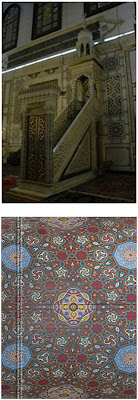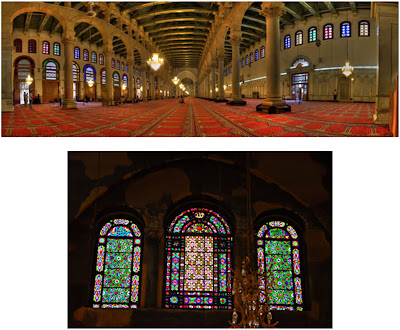Introduction
We were assigned to analyze buildings based on the Islamic principles implemented in structures. Here are few examples relating to Syria and Iraq timeline:
The Grand Mosque of Damascus
 |
| Figure 1: Great mosque of Damascus |
During
the first decade of the eight century, the Umayyad caliph Al-Walid bin Abd
Al-Malik is said to have addressed the damascene masses in the following terms:
“Inhabitants of Damascus, four things give you a marked superiority over the
rest of the world: your climate, your water, your fruits and your paths. To these
I wanted to add a fifth: This mosque.”
The
Grand Mosque of Damascus, known more commonly as the Umayyad Mosque,
The Great Mosque of Damascus is the first monumental work of architecture in
Islamic history; the building served as a central gathering point after Mecca
to consolidate the Muslims in their faith and conquest to rule the surrounding
territories under the Umayyad Caliphate.
Its renowned medieval manuscripts reinforced the Umayyad
mosque’s religious significance, and ranked as one of the wonders of the world
due to it is beauty and scale of construction.
Umayyad Mosque in Syria is dated back to 1200 years BC,
Where this place was a temple of the god "Haddad-Raman" the god of
fertility and thunder and rain, When the Romans entered Damascus, they built a
temple to the god Jupiter, and still has it’s lingering views which can be seen
from the harem souk area to the Qaimariya area. When Rome converted to
Christianity, the Church of John the Baptist was held in the North Western
region of the temple. And when the Muslims entered Damascus, they shared the
site of the church into two parts: the eastern section to become for Muslims
and the western part to become for the Christians. And when Al-Walid bin Abd
Al-Malik took the succession in 705, he wanted to build a mosque that has no
parallel in the East, and Christians satisfy to sell the other half of the church
in return for the Church of Ananias and other rights. Benefiting from what is
existed, Al-Walid began building the mosque and re-forms the existence part of
the church into an Islamic form and decorated with mosaics, miniatures and
engravings. And it was one of the best-decorated mosques in the history of
Islam. The Umayyad Mosque has the first minaret in Islam named Minaret of the “Arous”
which means “Bride”. Today, the mosque has three 'minarets, four gates and a
large dome called dome of the eagle, it also has three domes in the courtyard, four niches and huge murals
of mosaics and also halls and museum. Inside the mosque, there is a tomb of
Prophet Yahya (John the Baptist)
and beside him the hero Saladin.
The Umayyad mosque tends to portray the principle of unity
and uni-city of Allah “Tawhid” as it follows the ideas of the Prophet Mohammed
mosque of in Medina and the mosque stands on a sight surrounded by the oldest
continuously inhabited city in the world which shows unity and uni-city for the
city
 |
| Figure 2: Schematics of the mosque |
Also the principle of respect “Ihtiram” has been known as
symbolism, harmony and purity of geometry, which can be seen on the wall detail
inside the mosque.
 |
| Figure 3: Details of the Mosque represent Ihtiram |
And the principle of sincerity “Ikhlas” which can be
known as the integration of mathematics: embodiment of geometric proportion,
harmony and balance which can be seen on the “Mehrab” and also on the path to
the doors inside the mosque.
 |
| Figure 4: Principles of Ikhlas |
The principle of pursuit of knowledge “Ilm” which can be
defined as architecture of inscriptions by calligraphy, Arabic language or
reveal Ilm & wisdom word of quran. And also by using the light as
expression that illuminating affects of sunrays & moon light which can be
seen on the doors and windows of the mosque.
 |
| Figure 5: principal of Ilm |
The principle of remembrance “Dikr” can be defined as
rhythmic precision mirrored in the contemplative chanting of God’s innumerable attributes
“Dikr” which can be found on the dome and panels inside the mosque.
 |
| Figure 6: Principle of Dikr |
Refrences:
Book Name: The
Great Mosque of Damascus: Studies on the Makings of an Umayyad Visual.
No comments:
Post a Comment